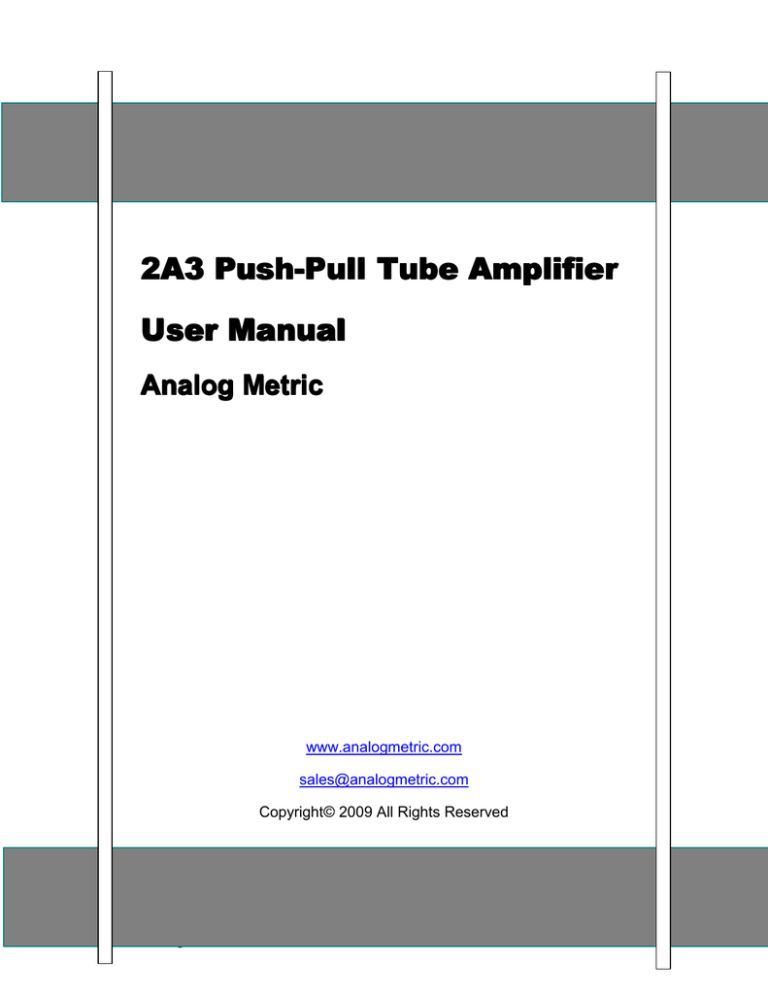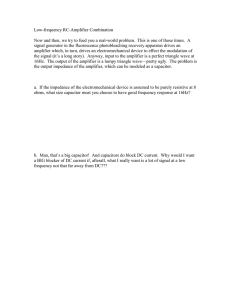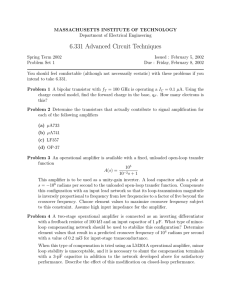
2A3 Push-Pull Tube Amplifier
User Manual
Analog Metric
www.analogmetric.com
sales@analogmetric.com
Copyright© 2009 All Rights Reserved
www.analogmetric.com
[2A3 Push-Pull Tube Amplifier
Amplifier]] Analog Metric
INTRODUCTION
This kit employs commonly used triode 2A3 vacuum tubes in push-pull configuration.
The first two stages uses pentode 6SJ7 (6J8P) for pre-amplifying and twin-triode 6SN7
tubes for phase splitter. The AC voltage is rectified by 5U4G/5Z3P rectifier tube. The
output power can reach 15W for each channel. This amplifier can be configured either
open loop gain or close loop gain. Optional chokes are left for DIYers' preferences.
www.analogmetric.com
2
[2A3 Push-Pull Tube Amplifier
Amplifier]] Analog Metric
www.analogmetric.com
3
[2A3 Push-Pull Tube Amplifier
Amplifier]] Analog Metric
FEATURES
•
Four 2A3, two 6SN7, two 6SJ7, and one 5Z3P (5U4G) vacuum tubes.
•
The input stage uses pentode 6SJ7 for pre-amplifying and the following stage uses
twin-triode 6SN7 for phase splitter.
•
The output stage uses two 2A3 tube configured as push pull. Output power can reach
15W for each channel.
•
Built-in tube (5Z3P/5U4G) and solid-state rectifier and regulation circuitry with two
inductors option in CLC filtering.
•
Two single-end input and two single-end output.
•
Input sensitivity: 1 Vrms
•
Input impedance: 100KΩ
•
Close loop voltage gain: 22dB
•
Variable resistor trimmer to adjust plate currents of the output stage tubes.
•
Support either open loop gain or close loop feedback.
•
Symmetrical layout design in signal paths for both channels.
•
Dedicated ground and power rails layout design.
•
Two large reservoir decoupling capacitors for power rails.
•
Power requirements: two 280V AC (100mA), two 6.3V AC (1.5A), two 2.5V AC
(5A), and 5V AC (3.5A)
•
Requires two 15W output push-push transformers with primary winding 3KΩ to
secondary winding 4/8Ω impedance transformation.
•
PCB dimension: 198mm (W) x 330mm (L)
•
PCB thickness: 2.4mm, double layer, 2oz copper.
www.analogmetric.com
4
[2A3 Push-Pull Tube Amplifier
Amplifier]] Analog Metric
PRECAUTIONS
•
Do not use any body parts to touch the metal parts of the kit after power up or power
off, since the high voltage capacitors may not fully discharge. It may cause serious
electric shock.
•
Use a power transformer with fuse (3A) socket to limit the supply current in case of
short circuit or incorrect assembly.
•
Double check the assembled components with the schematics.
•
Do not attempt the measure the voltage by multimeter with hand after power up. The
probes of the multimeter should be mounted by some stands to the points of the
measurement before switching on the power supply.
•
Turn off the power supply if you observe any smokes or hear strange sound coming
out from the transformer or board. If there is short circuit, the transformer will be
getting very hot shortly.
PROCEDURES
1. Hook up all the components according to the schematic, part list, and photos.
Notice to the polarity of the high voltage electrolytic capacitors (C1A, C1B, C3A,
C3B, C4A, C4B, C5A, C5B, C6A, C6B, C12, C7A, C7B, C11, C31 and C32)
C10, C11, C18, and C19). There are no polarities of the thin film capacitors. Also,
notice the direction of rectifier diodes D11 and D21.
2. Without plugging the tubes 6J8, 6SN7, and 2A3 tubes. Only plug the 5Z3P/5U4G
tube to the board. Apply power supply to the board, i.e. one 280V AC (100mA) to
connector JA and 5V AC (3.5A) to JB. After turn on the power supply, the 5Z3P
will be led up without drawing a lot current that is the voltages at JA and JB will
maintain more or less the same as before. Then, the rectifier unit work properly.
To more ensure, check the voltages at L11 (~365V DC) and L12 (~365V DC).
3. After switch off the power supply and wait several minutes to let high voltage
capacitor discharge. If you do not use the optional inductors, just short both the
connectors L11 and L12 by metal wires.
4. Now, plug in one 6SJ7 and one 6SN7 tubes (test one channel first), and turn on
power again. If everything works properly, the tubes will led up without drawing
substantial current.
www.analogmetric.com
5
[2A3 Push-Pull Tube Amplifier
Amplifier]] Analog Metric
5. If no any abnormal events, turn off the power and wait several minutes for
capacitive discharging. Then plug in two delicate 2A3 tubes and connect the
output transformer as following block diagrams, either open-loop or negative
feedback. Turn on the power again. Adjust the plate current by the 1W resistor
trimmer VR1 or VR2 so that the plate voltage of the tubes are the same (voltage at
first pin and third pin of J2A/J2B are the same).
www.analogmetric.com
6
[2A3 Push-Pull Tube Amplifier
Amplifier]] Analog Metric
6. Do the same procedure as above for another channel.
7. For negative feedback, connect the one terminal of secondary windings to the
connectors marked with "FBR", respectively.
8. Enjoy it.
www.analogmetric.com
7
[2A3 Push-Pull Tube Amplifier
Amplifier]] Analog Metric
www.analogmetric.com
8
[2A3 Push-Pull Tube Amplifier
Amplifier]] Analog Metric
CHECKLIST
1. The polarity of the high voltage capacitors C1A, C1B, C3A, C3B, C4A, C4B, C5A,
C5B, C6A, C6B, C12, C7A, C7B, C11, C31 and C32) C10, C11, C18, and C19.
2. The direction of diodes D11 and D12.
3. Either connecting L11 and L12 by chokes or short by wires.
4. The supply voltages at connectors one 280V AC (100mA), two 6.3V AC (1.5A), two
2.5V AC (5A), and 5V AC (3.5A).
5. Proper connecting of output transformers.
6. Proper mounting 2A3 tubes to socket.
If you have any problem
tech@analogmetric.com
www.analogmetric.com
in
assembly,
9
please
contact
us
by
email
to
[2A3 Push-Pull Tube Amplifier
Amplifier]] Analog Metric
www.analogmetric.com
10
[2A3 Push-Pull Tube Amplifier
Amplifier]] Analog Metric
www.analogmetric.com
11
Analog Metric
2A3 Push
Push--Pull Amplifier
Components
C1A, C1B
C2A, C2B
C3A, C3B
C4A, C4B, C5A, C5B
C6A, C6B, C12
C7A, C7B
C11
C31, C32
D11, D21
R1A, R1B
R2A, R2B
R3A, R3B
R4A, R4B
R5A, R5B
R6A, R6B
R7A, R7B
R8A, R8B
R9A, R9B
R10A, R10B, R11A, R11B, R11,
R12, R31, R32
R12A, R12B
R13A, R13B
R16A, R16B
R17
L11, L12
VR1, VR2
T1
T1A, T1B
T2A, T2B
T3A, T3B, T4A, T4B
4-Pin Plate PCB Mount Tube Socket
8-Pin PCB Mount Tube Socket
2-Pin Blue Connector
3-Pin Blue Connector
PCB
Value
0.47uF/200V
100uF/35V
22uF/250V
0.22uF/400V
47uF/450V
100uF/100V
100uF/450V
220uF/450V
6A10
100K 1W
100R 1W
27K 1W
82K 1W
1M 1W
22K 1W
30K 1W
1K 1W
20K 3W
Quantity
2
2
2
2
3
2
1
2
2
2
2
2
2
2
2
2
2
2
200K 1W
8
100R 5W
6.8K 1W
750R 10W
10R 1W
10H 250mA
100R
5Z3P/5U4G
6SN7
6J8P/6SJ7
2A3
2
2
2
1
2
2
1
2
2
4
4
5
9
5
1
Remark
Electrolytic Capacitor
Electrolytic Capacitor
Electrolytic Capacitor
MKP Film Capacitor
Electrolytic Capacitor
Electrolytic Capacitor
Electrolytic Capacitor
Electrolytic Capacitor
Optional, short without inductors
1W



